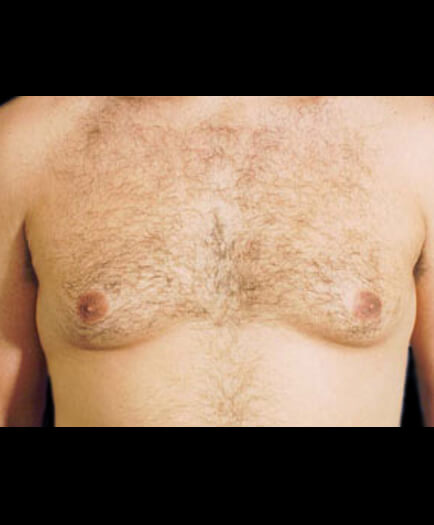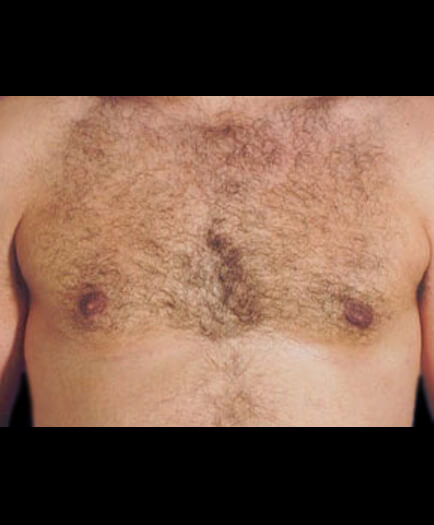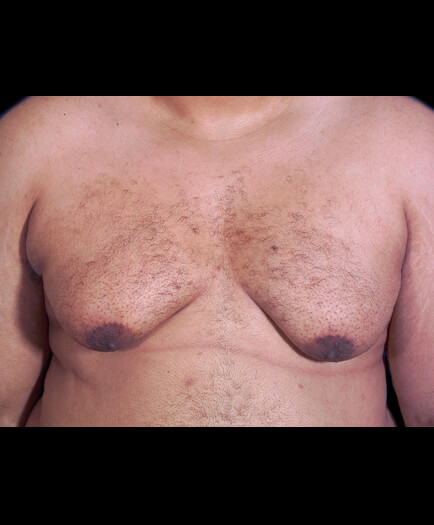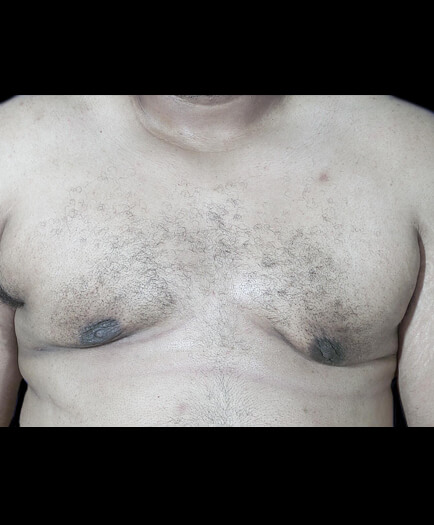A benign enlargement of the male breast, a condition known as gynecomastia, may be due to excessive fatty tissue, glandular tissue, or both. Gynecomastia excision, known as male breast reduction, is a procedure designed to remove unwanted fat and glandular tissue with minimal incisions from the male breast.
With liposuction and glandular excision, you can take away fat and breast tissue permanently. When you remove the fat cells from the breasts, the fat never comes back. You will still have some cells remaining in that area, but if the procedure is done correctly, it will have long-lasting effects. Similarly, the removal of glandular tissue is permanent. In most cases, the skin of the breasts contracts, and it is not necessary to remove excess skin. However, on occasion, the redundant skin may need to be excised. This is sometimes done at the same time of the initial surgery. Other times, it is done in a delayed fashion. Waiting several months may limit the length of the scar that the patient has in the breasts.
In the Virginia male breast reduction procedure, the breasts are first liposuctioned. This is done through a small puncture hole that is usually hidden in a natural fold of the body or around the nipple. The breasts are infiltrated with a solution containing medicines that reduce bleeding and postoperative pain, allowing large amounts of fat to be removed with little blood loss and no need for hospitalization. The glandular tissue is removed through one of the liposuction incisions under the nipple. Usually, these incisions heal very well and are hardly visible after a while.
After male breast reduction surgery, you will have a moderate amount of drainage from the liposuction incisions. You will need to rest for the first 2-3 days, but most people are up and about shortly after Virginia male breast reduction surgery. We generally recommend our patients take off 5-7 days from work. Heavy lifting and exercising should be avoided for the first two weeks. Your body will tell you when you are ready to get back into your regular exercise routine.
A benign enlargement of the male breast known as gynecomastia may be due to excessive fatty tissue, glandular tissue, or both. Male breast reduction is a procedure designed to remove unwanted fat and glandular tissue with minimal incisions from the male breast.
Gynecomastia repair is for men who have larger than normal breasts. This condition is very common and affects men starting at adolescence. The degree of breast enlargement varies, and the decision to have this corrected by surgery depends on the individual. Most men who have enlarged breasts cannot reduce the size by dieting and exercising. In some men, the loss of skin elasticity may result in sagging of the breast. The nipple falls below its natural position on the chest, which may require repositioning of the nipple, removal of the excessive skin, and fat and gland removal.
This procedure is not designed to treat widespread obesity. For patients who have excessive skin in the breast or who have lost the elasticity of their skin, a traditional skin resection may be necessary. If their body contouring irregularities are due to structures other than fat, such as bone or weaknesses in the muscles, these problems cannot be corrected by this operation. On occasion, it may be necessary to address these problems at a later date with other surgical procedures.
With liposuction and glandular excision, fat and breast tissue can be taken away permanently. When the fat cells are removed from the breasts, the fat never comes back. There will still be some fat cells remaining in that area, but if the procedure is done correctly, it will have long-lasting effects. Similarly, the removal of glandular tissue is permanent. In most cases, the skin of the breasts contracts, and it is not necessary to remove excess skin. However, on occasion, the excess skin may need to be excised. This is sometimes done at the same time of the initial surgery; other times, it is done in a delayed fashion. Waiting several months may limit the length of the scar that the patient has in the breasts.
In the first consultation, you will have a chance to discuss your concerns with our patient care coordinators and Dr. Marefat. We will explain what you need to know about Virginia male breast reduction surgery and help to determine what is best for you. You will receive information booklets and pricing on the procedure.
The breasts are first infiltrated with a solution containing medications that cut back on bleeding and postoperative pain. This tumescent solution makes it possible to remove large amounts of fat with little blood loss and no need for hospitalization. The breasts are then liposuctioned. This is done through small puncture holes that are usually hidden in natural folds of the body or around the nipple. The glandular tissue is removed through a small incision in the nipple area. The incisions heal very well and are hardly visible after a while. If there is need for skin excision, it can be done with incisions around the nipple and under the breast. Dr. Marefat usually does not remove the extra skin immediately. He prefers to wait and remove it in a secondary procedure several months later. This will give your skin a chance to contract down, which can significantly reduce the length of your scar.
Our objective is to improve the shape and proportions of the breasts. However, we cannot change the nature of the skin. We want to establish normal proportions and give the chest a better balance. We also want to improve the patient's appearance both in and out of clothing.
This procedure is usually done either with general anesthesia or intravenous sedation. In either case, local injection of the tumescent solution is used to decrease blood loss and postoperative pain. With the tumescent technique, the requirements for giving IV sedation or general anesthesia are also decreased, so there is less risk of side effects as a result of these anesthetics.
After Virginia male breast reduction surgery, you will have a moderate amount of drainage from the liposuction incisions. You will need to rest for the first 2-3 days, but most people are up and about shortly after surgery. We generally recommend our patients take off 5-7 days from work. Heavy lifting and exercising should be avoided in the first 2 weeks. Your body will tell you when you are ready to get back into your regular exercise routine. You will need to wear support garments for approximately 4-6 weeks after Virginia male breast reduction surgery. This helps in the attachment of the skin back to the underlying tissues after liposuction and reduces the chance of fluid collection under the skin. During this interval, you can remove the garment to shower and rest your skin for short periods of time. There will be some numbness associated with the surgery. This numbness usually persists for about 4-6 weeks. Minor lumps and irregularities are common after liposuction. These irregularities are related to accumulations of fluid in certain areas of the subcutaneous fatty layer of the skin as a result of either infiltration of the fluid or as a result of the trauma associated with liposuction. Irregularities even out after the first 2-3 weeks after the surgery. Minor asymmetry between the 2 sides of the body can be seen after liposuction. This, too, is related to accumulations of fluid or trauma related to the operation. These asymmetries usually resolve within 2-3 weeks after the surgery.
Not usually. However, this is still the most common aesthetic complication of gynecomastia repair. The removal of the glandular tissue from under the nipple can sometimes result in depression or irregularity in this area. One way to avoid this is for the doctor to use very small gauge cannulas and to take his or her time removing the fat and glandular tissue. However, even when everything is done right, there is still a chance that you may develop some irregularity. If this does occur, we usually fix this problem in a touch-up procedure. This touch-up procedure is done approximately 3 months after the initial surgery.
Before you focus on the complications of gynecomastia excision, first consider how best to digest these bits and pieces of information. Reading about complications can be quite scary. Many people cannot comfortably sit through a consultation session without having some real doubts about surgery. But it is different when you have these complications explained to you by Dr. Marefat. He can put them in perspective for you and tell you the likelihood of such complications occurring. Most complications are very rare. Some are less rare and need to be explained to you in more detail so that you know how we would tackle these problems if they occurred. The purpose of explaining risks and complications is for you to know what steps we would take to treat you and put you back on the road to recovery. Remember that every surgeon has his or her own way of treating problems. You must go over these potential risks with your surgeon to gain better insight and understanding.
Touch-ups are done after 3 months. These procedures are much simpler than the first procedure and are not as painful. They are done in our Virginia office with a small amount of local anesthetic solution.
There are very few sutures in gynecomastia excision procedures in general. These usually come out in 1-2 weeks. You may have absorbable sutures that do not need to come out.
We like to see our patients frequently after surgery. You are seen by Dr. Marefat or a nurse within 2-3 days of male breast reduction surgery. Then, the normal postoperative routine is 1 week, 1 month, 3 months, 6 months, and 12 months. Of course, if there is a need, you may be seen more often. After the first year, we encourage our patients to come in for routine follow-up visits every 3-5 years.
You are a good candidate for gynecomastia excision if you have localized areas of fat collection, good skin tone, good general health, and realistic expectations. This does not mean that you cannot have Virginia male breast reduction surgery if you do not meet these criteria. However, the best results are seen in individuals who have 1-2 areas of localized fat in their body that don’t go away with dieting and exercising. Generally, the younger you are, the better a candidate you are for surgery. A person’s physiological age is more important than his chronological age. That is to say, you may be 60 years old, but your skin and general health may be better than that of most 50 year olds.
You can pay for Virginia male breast reduction surgery by certified check, credit card, or cash. Payment for cosmetic surgery is expected prior to any procedure. If you are scheduled for surgery several weeks in advance, you may pay by personal check.
Yes. However, these scars are very small (about 1/8th of an inch) and are usually hidden in areas of the body where you would not normally see them. Each area of liposuction will generally have 1 or 2 small scars. After several months, these scars fade and are hardly visible.
If glandular tissue is being removed, it will be through a half-inch incision in the areola (the darker skin surrounding the nipple). If you have excess skin after liposuction, this may need to be trimmed. In this case, you will have a permanent scar in the area of skin excision.
The pain involved in Virginia male breast reduction is very tolerable. We have heard our patients describe it as muscle aches and pains or just soreness. Many patients do not finish the pain medications prescribed to them for pain relief. Having said that, remember that pain is very subjective, and it is not easy to predict what degree of pain you will have.
No. Virginia male breast reduction is almost always done with the patient under general anesthesia. In certain cases when general anesthesia is not advised, we can do this procedure with heavy sedation. If you are having a minor area touched up or liposuctioned, this can be done in the office while you are awake with local anesthesia.
Virginia male breast reduction surgery is usually done in an outpatient facility. We rarely see the need to perform this operation in a hospital setting. Only in rare situations when the patient may have risk factors does Dr. Marefat suggest surgery in a hospital environment.
BEFORE

AFTER

BEFORE

AFTER

Yes. In all cosmetic and reconstructive cases, medical photos are taken. Photographs are mandatory. This is the only way for us to compare your status before the procedure to your results. Photographs in plastic surgery serve much the same role that x-rays serve for orthopedic surgery.
Dr. Marefat and the staff at Metropolitan Plastic Surgery would be happy to help you set up a private consultation to discuss gynecomastia repair (male breast reduction) in Virginia. Schedule an appointment online or call one of our locations at 703-516-7600 (Arlington area) or at 703-560-9583 (Woodbridge).
Dr. Marefat offers a number of financial assistance programs and payment programs to cover the cost of gynecomastia repair (male breast reduction) in Virginia. Please visit the patient financing section of our website for more details or ask the staff at Metropolitan Plastic Surgery about these options so that you can get started with gynecomastia repair (male breast reduction) in Virginia today.